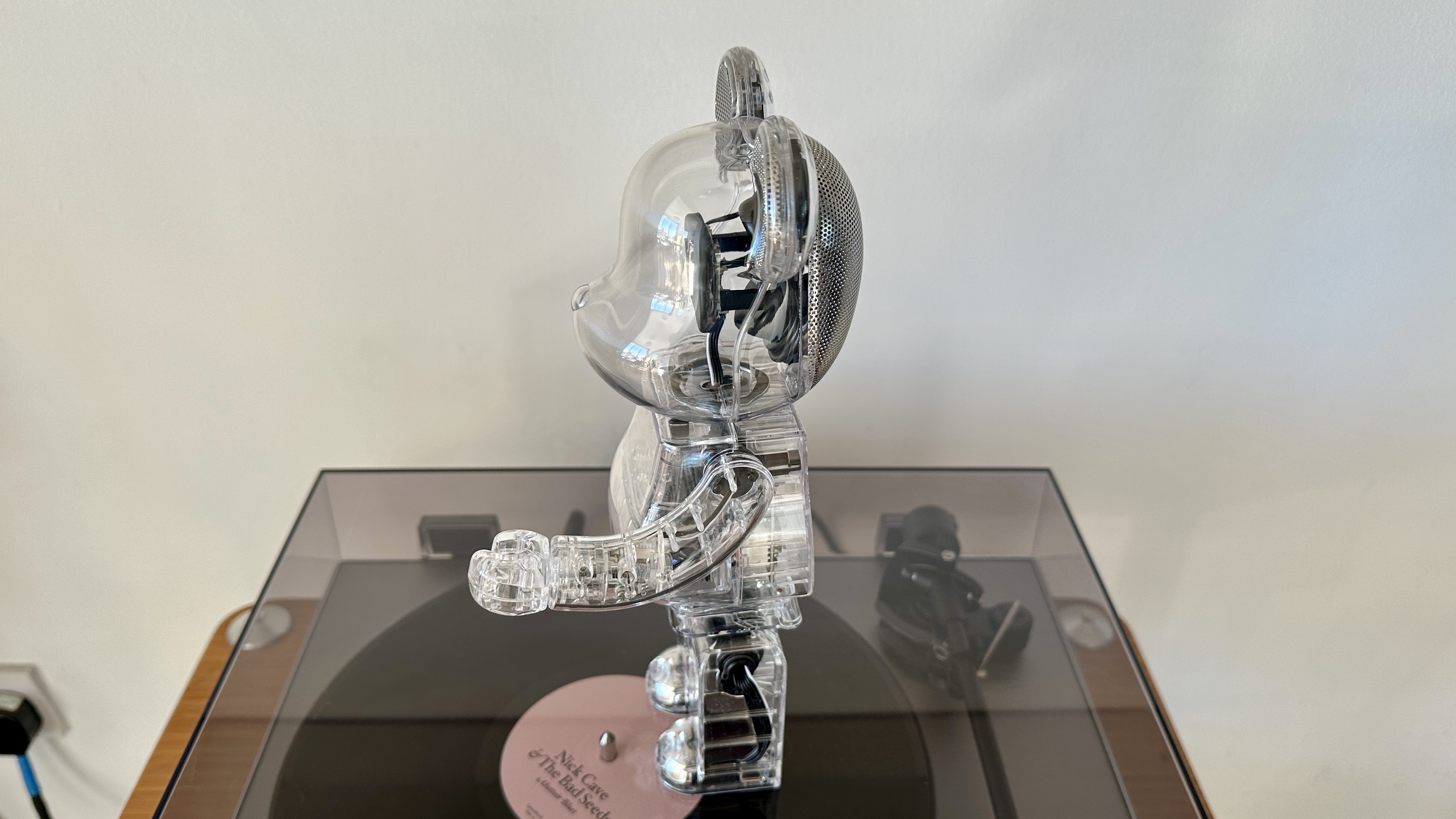I tried the expensive yet eccentric Bearbrick Bluetooth speaker, and I didn't hate it
A bear-shaped Bluetooth speaker (yes, you read that right)

There are two things you need to know before we get into the nuts and bolts of one of the weirdest wireless speakers we've ever come across (the Bearbrick is so unique and outrageously priced, it will likely never feature among the best Bluetooth speakers we've tested but that's not to say it's not one of the most interesting we've come across).
The first is that Medicom Toy (purveyors of collectible action figures, vinyl dolls and what-have-you) has achieved something very close to ubiquity with its Bearbrick model. There isn’t a design museum worthy of the name that doesn’t have one or two examples knocking about, and there are literally thousands of variations of its ‘400%’ model available on the company’s website. Fancy a Bearbrick as Tweety-Pie? Or as Andy Warhol? Or one or other of Daft Punk? Go right ahead.
The other is that I’ve been reviewing audio equipment for over two decades now, and in that time I’ve never really deviated from the opinion that a product needs to perform to a standard that justifies its asking price if I’m not going to stick the boot in. I’ve lost track of the number of times a manufacturer (or its representatives) has tried to tell me that because a product is gold-plated, or limited-edition, or endorsed by a musician, then the rules of ‘quality per quid’ shouldn’t apply. Naturally I’m always very polite, but equally naturally I don’t find it all that difficult to disregard this nonsense.
Rinaro doesn't make toys

While I always try my utmost not to pre-judge equipment, I can’t pretend I didn’t have my reservations about the Bearbrick Audio 400 ahead of its arrival. An unsmart Bluetooth speaker? An dumb (i.e. no Wi-Fi) Bluetooth speaker with poseable arms and legs? Costing $500 / £595 / AU$760? I know only too well that writing a negative review is generally easier (and more fun) than writing a positive review, but really… this looked like shooting fish in a barrel.
But then again, the press release mentioned input from Ukraine’s Rinaro Isodynamics. I’m familiar with Rinaro Isodynamics, which is a hugely well-regarded brand in audiophile circles thanks to its acknowledged excellence where high-end stuff like planar magnetic drivers are concerned.
I had first-hand experience of its expertise very recently, when I reviewed a $3,000 / £2,750 / AU$4,560-worth of Meze Audio headphones that featured Rinaro Isodynamics componentry (like the Meze Audio Liric) – and as listening experiences go, this one was prodigious. Rinaro’s involvement in the Audio 400 made me wonder if it was actually going to be more than a frippery and an irrelevance after all…
Childish or the cutest thing imaginable?

Once the Bearbrick Audio 400 itself arrived, I was able to give the product proper consideration. On the plus side, a four-driver array (two 20mm polypropylene tweeters, one in each ear, and two 40mm carbon paper cone mid/bass drivers angled out from the rear of the bear’s cranium) designed to deliver omnidirectional sound and powered by 20 watts of Class D amplification, looks good on paper.
Sign up for breaking news, reviews, opinion, top tech deals, and more.
Bluetooth 5.0 with codec compatibility limited to SBC and AAC, on the other hand, does not. Six hours of battery life is sort-of OK, I suppose. And I was conflicted about the control options – is twisting the bear’s left paw to adjust volume and its right paw to skip forwards or backwards through my playlist simply juvenile? Or is it the cutest thing imaginable?
With the (replaceable) battery charged – via the USB-C socket in the bear’s left heel - and a wireless connection to a Samsung S23 Ultra smartphone made, it was time for some critical listening. Standing upright, and with its arms by its sides, the Audio 400 is a tidy 280 x 132 x 70mm (HxWxD) – the perfect size, in other words, to stand on my desk and peer over my laptop while I listen to that endless playlist of test-tunes I’ve been compiling for years.
A spacious, tonally balanced listen

Like I said, I’ve been doing this sort of work for an awfully long time now – but I can count on the fingers of one hand the occasions when I’ve encountered a product I’m prepared to cut even the merest hint of slack where performance-per-pound is concerned.
And despite the fact that it’s got some real positives where its audio presentation is concerned – it’s quite spacious, tonally balanced, reasonably punchy and quite eloquent, through the midrange in particular – the Bearbrick Audio 400 is not without its issues. The idea that its sound is omnidirectional, for instance, is fanciful. It’s basically flat where dynamics are concerned. Yes, it’s an energetic and quite well-controlled listen – but if you turn the volume right down it becomes noticeably bass-forward.
And for a hard-nosed and dispassionate individual like me, of course, the biggest problem is the price. $500 / £595 / AU$760 is a lot for a dumb Bluetooth speaker, and it’s even more to pay for a Bluetooth speaker that doesn’t offer class-leading sound. In all honesty, you can spend $300 / £349 / AU$520 on a DALI Katch G2 and get more complete audio performance. Does the DALI look like a bear? No, it doesn’t. Does it represent better value for money than the Audio 400? You bet your boots it does.
The Bang & Olufsen phenomenon

In this instance, there’s more in play than whether or not a particular product represents good value for money. For years, I’ve privately referred to this as ‘the Bang & Olufsen phenomenon’. It’s my experience that Bang & Olufsen customers are well aware they’re paying a premium for design, and could achieve similar performance from a non-B&O alternative for quite a lot less money if they were prepared to forgo the ‘design’ element – but they’re not. Bang & Olufsen customers know they’re paying over the odds in pure performance terms, and they don’t care.
The Bearbrick Audio 400 is a similar proposition. I don’t think it’s any kind of coincidence that the only bricks-and-mortar retailer in the United Kingdom that’s stocking it is Selfridges – in the US, you can find it selling for a slight premium on MOMA's site. It’s a product that will sell to a very specific customer base that couldn’t give a toss whether or not they can get similar sound quality from a less dramatic-looking speaker costing quite a lot less money. They want the bear with the speakers in its ears.
I wanted to dislike the Bearbrick Audio 400. I wanted it to be a cynical exercise in marketing, and a ploy to fleece the credulous. But it isn’t – not entirely, anyway. I quite like it. Not enough to consider spending $500 / £595 / AU$760 on one, of course, but I’m certainly not about to put the boot in.
You might also like

Simon Lucas is a senior editorial professional with deep experience of print/digital publishing and the consumer electronics landscape. Based in Brighton, Simon worked at TechRadar's sister site What HiFi? for a number of years, as both a features editor and a digital editor, before embarking on a career in freelance consultancy, content creation, and journalism for some of the biggest brands and publications in the world.
With enormous expertise in all things home entertainment, Simon reviews everything from turntables to soundbars for TechRadar, and also likes to dip his toes into longform features and buying guides. His bylines include GQ, The Guardian, Hi-Fi+, Metro, The Observer, Pocket Lint, Shortlist, Stuff T3, Tom's Guide, Trusted Reviews, and more.